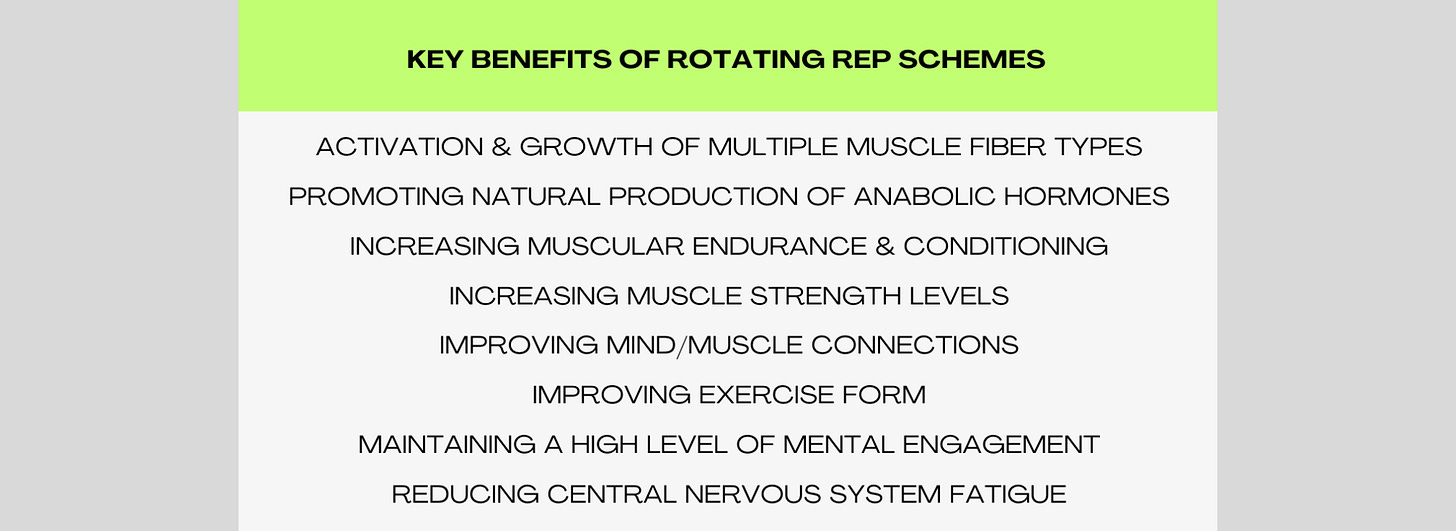The Fundamentals Series - Rotating Rep Ranges
How To Use Rotating Rep Ranges To Maximize Muscle Growth & Strength
Think back to the first time you hit the weight room. You walked into this brand new world composed of iron, muscle, and sweat. You saw muscular people lifting heavy weights, heard the sounds of strain and hard physical work, and saw others who represented exactly what you wanted to become. Now let me ask you this; on that very first day, do you remember how many reps per exercise you did?
Raise your hand if it was 10. This is the classic go-to starter rep range. If this was you, you’re one of millions who did the same thing during their very first training day.
I can’t tell you why 10 reps is the most popular rep range. I’m sure some big-name magazine kicked it off back in the day. Or, maybe Arnold said it was the way to do it in the 80s. Exactly why it’s the rep range king of the hill doesn’t really matter. What matters is that you include it in your training, BUT, that it isn’t the only rep range you should include in your training. And that ‘BUT’ is hugely important!
The Light Bulb Moment
Have you ever had a moment in your life where something just clicked? You either did something that felt so right or you realized something that seemed so obvious in hindsight, but yet, so valuable in the moment. That satisfying moment of discovery is 'the click.'
These moments can be related to minor or major aspects of life. When you have a click moment, you better be taking notes and putting your realization to use in the future!
You'll often hear people refer to these click moments as ‘light bulb’ moments too. On TV, you'll see an imaginary light bulb floating over a cartoon character's head and when something clicks for them, the bulb lights up.
One of the biggest 'light bulb' moments of my training career happened when I realized that in order to make the most constant, reliable, and fun strength and size gains possible, I needed to start varying the number of reps per set I performed during my workouts.
This is a very important training concept, and if you don't realize how important it is, then you probably haven't experienced how much this concept can rocket your progress forward.
An example of a rep range rotation is:
Week 1: 20 rep sets
Week 2: 10 rep sets
Week 3: 5 rep sets
Week 4: Repeat Week 1
As you can see, the example above rotates through high rep, medium rep, and low rep work. Each of these rep ranges provides specific growth and strength benefits. If you aren’t putting your body through all of these paces, you’re not experiencing each of their special benefits.
Note: I'm not saying to switch up your exercises each week. I'm only talking about changing up the reps.
Any valuable program is going to require performing the same exercises for multiple weeks. This is how you actually make progress in exercises. You use them repeatedly and give yourself time to improve with them. Sticking to a set of quality exercises for a prolonged period of time is a hugely important concept, and I’ll probably get into it in a later article, but today we’re talking about rep ranges.
The Benefits of Rotating Rep Ranges
Any valuable program will also have multiple workouts focused on multiple goals and aspects of training (strength, size, conditioning, speed, etc), which can only be accomplished if rotating rep ranges are present.
This is where rotating rep ranges steps up to the plate and hits a 500-foot bomb every time. Rotating rep ranges delivers a grand slam of benefits. I’ve listed my favorites in the table below, but these aren’t the only benefits of rotating rep ranges. The list truly does go on.
Which Rep Ranges Should You Use?
Rep ranges can vary from one to infinity, so knowing which rep ranges to rotate through isn’t obvious. The question ‘which rep ranges should I use?’ is common. Let’s get into the answer.
I prefer to keep things simple and work with rotations which always include high, medium, and low range work. This will provide you with all of the benefits I mentioned above, and more.
You can choose to define the exact rep range of each of those levels with your own numbers, and there is definitely going to be some differing opinions on this, but I prefer to stick to the following guidelines:
If your preferences differ, that’s OK. I’m not going to nitpick this stuff and my goal is really just to see you rotating reps, period. What I will say, is that for years and years I’ve seen those who follow my guidelines absolutely crush it in the muscle growth and strength gain departments. Take that information and do with it what you wish.
Which Rotation Works Best?
Now that I’ve covered benefits and rep range guidelines, it’s time to talk about the actual rotations you can use to tailor your training program to your main training priority.
This is an important section of this article because you can’t actually put rotating rep ranges to use without a plan of action.
Below, I’m going to outline four different possible rotation schedules and who should use each one.





